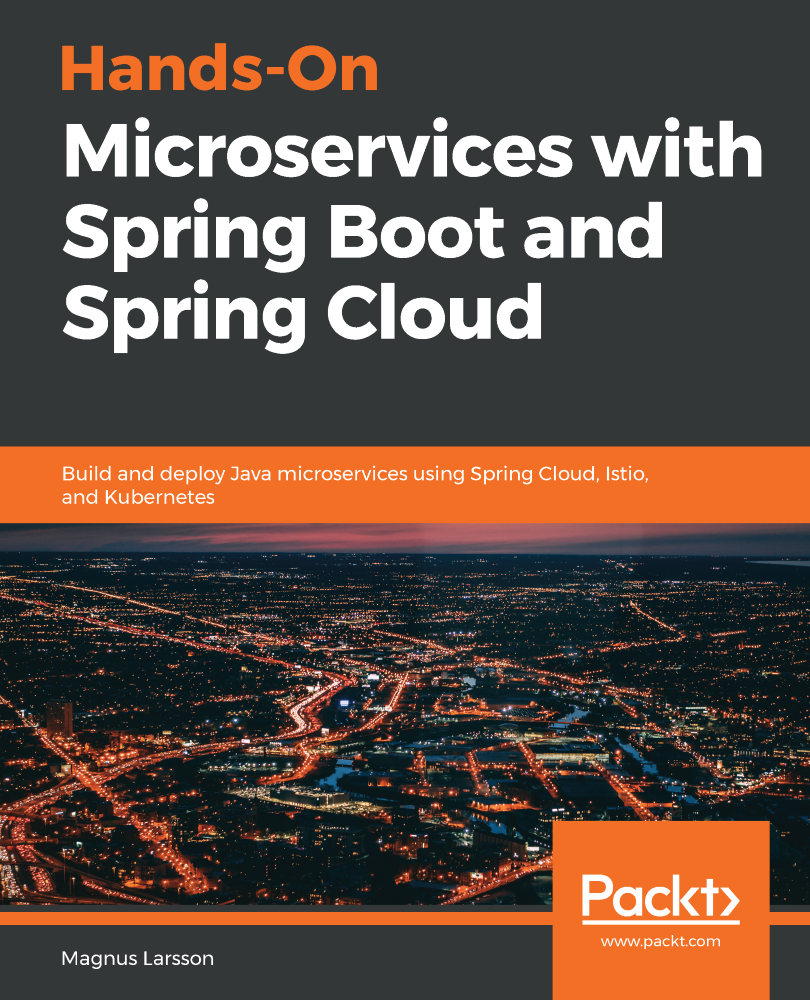If you have read this book, please leave a review on Amazon.com. Potential readers can then use your unbiased opinion to help them make purchase decisions. Thank you. The $5 campaign runs from December 15th 2020 to January 13th 2021.
The second edition of the book is now released, see Amazon.com.
It has been updated for the most recent versions of Spring, Java, Kubernetes, and Istio. In addition, support is added for building and running all examples on a Windows PC using WSL 2. Finally, a chapter has been added about native compile, enabling Java-based microservices to start up in a fraction of a second.
Here is a summary of the most significant changes and news in the second edition: blog post.
The GitHub repo for the second edition can be found here: https://github.com/PacktPublishing/Microservices-with-Spring-Boot-and-Spring-Cloud-2E.git.
This is the code repository for Hands-On Microservices with Spring Boot and Spring Cloud , published by Packt.
Build and deploy Java microservices using Spring Cloud, Istio, and Kubernetes
Microservices architecture allows developers to build and maintain applications with ease, and enterprises are rapidly adopting it to build software using Spring Boot as their default framework. With this book, you’ll learn how to efficiently build and deploy microservices using Spring Boot.
This book covers the following exciting features:
- Build reactive microservices using Spring Boot
- Develop resilient and scalable microservices using Spring Cloud
- Use OAuth 2.0/OIDC and Spring Security to protect public APIs
- Implement Docker to bridge the gap between development, testing, and production
- Deploy and manage microservices using Kubernetes
- Apply Istio for improved security, observability, and traffic management
If you feel this book is for you, get your copy today!
All of the code is organized into folders. For example, Chapter02.
The code will look like the following:
management.endpoint.health.show-details: "ALWAYS"
management.endpoints.web.exposure.include: "*"
logging.level.root: info
Following is what you need for this book: This book is for Java and Spring developers and architects who want to learn how to break up their existing monoliths into microservices and deploy them either on-premises or in the cloud using Kubernetes as a container orchestrator and Istio as a service Mesh. No familiarity with microservices architecture is required to get started with this book.
With the following software and hardware list you can run all code files present in the book (Chapter03-20).
| No. | Software required | OS required |
|---|---|---|
| 1 | Spring | Windows, macOS, Linux |
| 2 | Docker CE | Windows, macOS, Linux, see supported platforms |
We also provide a PDF file that has color images of the screenshots/diagrams used in this book. Click here to download it.
-
Page 5 (Contributors): My college Erik Lupander should be My colleague Erik Lupander
-
Page 14 (Paragraph 1, line 2): that we were not exposed should be that we were not exposed to
-
Page 40 (Paragraph 3, line 1): When the Spring Framework was released in v1.0 back in 2004, it was released in order to fix the overly complex… should be The Spring Framework v1.0 was released back in 2004 to fix the overly complex…
-
Page 102 (Last paragraph, line 2): Once the CoreOS server has started running in its container you can, for example, ask what version of CoreOS that it runs with the cat /etc/redhat-release command. should be Once the CoreOS server has started running in its container, you can, for example, ask what version of CoreOS it is running using the cat /etc/redhat-release command.
-
Page 370 (Adding programmable delays and random errors section) faultPercentage: Causes the getProduct API on the product microservice... should be faultPercent: Causes the getProduct API on the product microservice to..
-
Page 370 (Changes in the API definitions section) The two query parameters that we introduced previously, delay and faultPercentage, have been defined in the api project in the following two Java interfaces... should be The two query parameters that we introduced previously, delay and faultPercent, have been defined in the api project in the following two Java interfaces...
- July 26, 2020: Source code updated to use SpringFox 3.0.0, Spring Boot 2.3.2 and Spring Cloud Hoxton SR6. For details, see added support for SpringFox 3.0.0.
Magnus Larsson has been in the IT industry for 35 years, working as a consultant for large companies in Sweden such as Volvo, Ericsson, and AstraZeneca. In the past, he struggled with the challenges associated with distributed systems. Today, these challenges can be handled with open source tools such as Spring Cloud, Kubernetes, and Istio. Over the last years, Magnus has been helping customers use these tools and has also given several presentations and written blog posts on the subject.
Click here if you have any feedback or suggestions.


